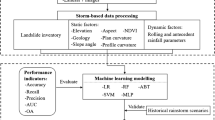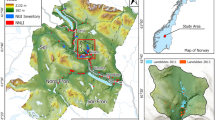Abstract
Landslides are among the most destructive natural events, being their prediction necessary to prevent damage to people and infrastructure. This is a problem traditionally addressed with conventional methods, of a deterministic nature, with a limited number of variables and a static treatment of them. In this paper, we propose an approach based on Machine Learning, which has proven to be a successful alternative for dealing with geo-environmental problems. A feature engineering process allowed us to determine the most influential geological, geo-morphological and meteorological factors in the occurrence of landslides. These variables together with the landslide inventory, form a dataset to train different machine learning models, whose evaluation and comparison showed the best performance of the multi-layer perceptron with an accuracy of 99.6%. Our contribution consists of treating precipitation dynamically with the use of time windows for different periods. In addition, we determined the ranges of values of the conditioning factors that combined would trigger a landslide for each time window. Both the multi-temporal prediction and the thresholds of the conditioning factors provide technical support for decision making in risk management.
Access this chapter
Tax calculation will be finalised at checkout
Purchases are for personal use only
Similar content being viewed by others
References
Achour, Y., Pourghasemi, H.: How do machine learning techniques help in increasing accuracy of landslide susceptibility maps? Geosci. Front. 11 (2019). https://doi.org/10.1016/j.gsf.2019.10.001
Mora, R., Vahrson, W., Mora, S.: Mapa de Amenaza de Deslizamientos, Valle Central, Costa Rica. In: Centro de Coordinación para la prevención de desastres naturales en América Central (CEPREDENAC) (1992)
Rajakumar, P., et al.: Landslide susceptibility mapping in a hilly terrain using remote sensing and GIS. J. Indian Soc. Remote Sens. 35 (2007). https://doi.org/10.1007/BF02991831
Santos, D., Dallos, L., Gaona-García, P.A.: Algoritmos de rastreo de movimiento utilizando técnicas de inteligencia artificial y machine learning. Información tecnológica 31, 23–38 (2020)
Đurić, U., et al.: Machine learning based landslide assessment of the Belgrade metropolitan area: pixel resolution effects and a cross-scaling concept. Eng. Geol. 256, 23–38 (2019)
Arabameri, A., et al.: Landslide susceptibility evaluation and management using different machine learning methods in the Gallicash River Watershed, Iran. Remote Sens. 12 (2020). https://doi.org/10.3390/rs12030475
Di Napoli, M., Carotenuto, F., Cevasco, A., Confuorto, P., Di Martire, D., Firpo, M., Pepe, G., Raso, E., Calcaterra, D.: Machine learning ensemble modelling as a tool to improve landslide susceptibility mapping reliability. Landslides 17(8), 1897–1914 (2020). https://doi.org/10.1007/s10346-020-01392-9
Saha, S., et al.: Machine learning-based gully erosion susceptibility mapping: a case study of Eastern India. Sensors 20(5), 1313 (2020)
Rodríguez, B.G., Salvador-Meneses, J., Garcia-Rodriguez, J.: Predicting landslides with machine learning methods using temporal sequences of meteorological data. In: Sanjurjo González, H., Pastor López, I., García Bringas, P., Quintián, H., Corchado, E. (eds.) SOCO 2021. AISC, vol. 1401, pp. 348–357. Springer, Cham (2022). https://doi.org/10.1007/978-3-030-87869-6_33
Ba, Q., Chen, Y., Deng, S., Yang, J., Li, H.: A comparison of slope units and grid cells as mapping units for landslide susceptibility assessment. Earth Sci. Inform. 11(3), 373–388 (2018). https://doi.org/10.1007/s12145-018-0335-9
Pham, B.T., et al.: A novel ensemble classifier of rotation forest and Naive Bayer for landslide susceptibility assessment at the Luc Yen district, Yen Bai Province (Viet Nam) using GIS. Geomat. Nat. Hazards Risk 8(2), 649–671 (2017)
Ali, S.A., et al.: GIS-based landslide susceptibility modeling: a comparison between fuzzy multi-criteria and machine learning algorithms. Geosci. Front. 12(2), 857–876 (2021)
Guzzetti, F., et al.: Landslide inventory maps: new tools for an old problem. Earth Sci. Rev. 112(1), 42–66 (2012). ISSN: 0012-8252. https://doi.org/10.1016/j.earscirev.2012.02.001. https://www.sciencedirect.com/science/article/pii/S0012825212000128
Lu, P., et al.: Landslide mapping from multi-sensor data through improved change detection-based Markov random field. Remote Sens. Environ. 231, 111235 (2019)
Merghadi, A., et al.: Machine learning methods for landslide susceptibility studies: a comparative overview of algorithm performance. Earth Sci. Rev. 207, 103225 (2020)
Author information
Authors and Affiliations
Corresponding author
Editor information
Editors and Affiliations
Rights and permissions
Copyright information
© 2022 Springer Nature Switzerland AG
About this paper
Cite this paper
Guerrero-Rodriguez, B., Garcia-Rodriguez, J., Salvador, J., Mejia-Escobar, C., Bonifaz, M., Gallardo, O. (2022). Landslide Prediction with Machine Learning and Time Windows. In: Ferrández Vicente, J.M., Álvarez-Sánchez, J.R., de la Paz López, F., Adeli, H. (eds) Bio-inspired Systems and Applications: from Robotics to Ambient Intelligence. IWINAC 2022. Lecture Notes in Computer Science, vol 13259. Springer, Cham. https://doi.org/10.1007/978-3-031-06527-9_19
Download citation
DOI: https://doi.org/10.1007/978-3-031-06527-9_19
Published:
Publisher Name: Springer, Cham
Print ISBN: 978-3-031-06526-2
Online ISBN: 978-3-031-06527-9
eBook Packages: Computer ScienceComputer Science (R0)




